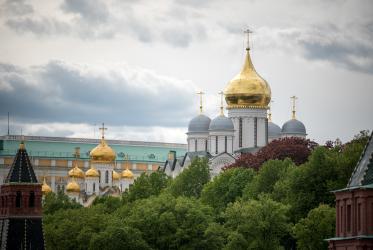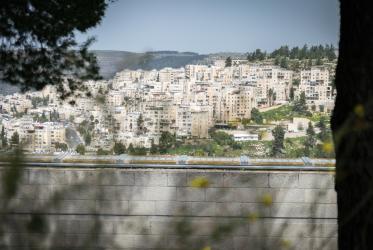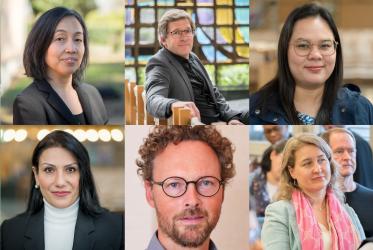*By Odair Pedroso Mateus
Jürgen Moltmann looked astonished when he saw his name on the list of contributors. In a recent dinner at the Ecumenical Institute in Bossey, my colleague Stephen Brown, the editor of The Ecumenical Review, surprised him with a 50-year old brochure.
Its cover remains as black as the “Thursdays in Black” campaign. But the lignin pages, apparently printed from mimeographed texts, evoke now old newspapers: they have turned yellowish-brown. They bear now the utopian authority of the late 1960s. They smell as the small library in which I had my first job as a high-school student.
The brochure is a collection of papers presented in a consultation held 50 years ago, in November 1969 in Cartigny, nearby Geneva, by a unique ecumenical joint-venture between Rome and Geneva, the Catholic Church and the World Council of Churches (WCC): The Joint Committee for Society, Development and Peace known ever since as “Sodepax,” an acronym persistently associated in my mind with imagination, innovation, disillusion and some mystery.
Rome and Geneva established Sodepax in 1968, the year in which a bullet shot on 4 April under a blue Memphis sky resounded on Sunday afternoon 7 July in the Aula of the University of Uppsala, when the black American writer James Baldwin addressed the WCC fourth assembly in the tragic absence of Martin Luther King: I address you, Baldwin said, “as one of God’s creatures whom the Christian Church has most betrayed.”

Ecumenical Review Editor Dr Stephen Brown shows Jürgen Moltmann in December 2019 the report of the 1969 Sodepax Consultation. Photo: Marianne Ejdersten/WCC
New global village
Rome and Geneva were then deeply convinced that the church was called to play an active role in the new “global village,” the emerging modern, globalised and secularised world. The great Catholic council of the early 1960s had taught that the church is a sign of the unity of humanity and proclaimed in the same vein that “the joys and hopes, the griefs and the anxieties of the men of this age, especially those who are poor or in a way afflicted, these too are the joys and hopes, the griefs and anxieties of the followers of Christ.” The WCC 1968 assembly, in line with a conference on church and society held in Geneva in July 1966, echoed this same vision by stating, though somewhat critically that “the Church is bold in speaking of itself as the sign of the coming unity of mankind.”
These converging visions of the church actively engaged in the modern world raised the question of what could be a Christian contribution to social and economic development and how it would be implemented in different contexts. They were the theological-practical ground and horizon of Sodepax.
Furthering the cause
In a time when ecumenical pessimists used to joke that an ecumenical enterprise is undertaken by people who separately say they can do nothing and as a group decide that nothing can be done, Sodepax was decided to prove that the contrary was true. An experimental, flexible, future-oriented movement rather than a bureaucratic structure, Sodepax embodied, in the words of its general secretary Joseph J. Spae, the resolve of different Christian traditions to “search together for ways and means of furthering the cause of social justice, development and peace.”
Sodepax quickly established local and national Sodepax groups in Asia, Africa and Latin America meant to decentralise its agenda; launched programmes on education for development, mobilisation for peace, working with people of other faiths; and held large international conferences on human development, peace in Northern Ireland, the churches’ role in the development in Asia, and the one on a theology of development whose black-covered report my colleague Stephen Brown showed to a surprised Jürgen Moltmann.
But Sodepax “quietly died,” in the words of John C. Bennett, in its early adolescence in 1980. Why? Tom Stransky once wrote that Sodepax was “the victim of its own vigorous successes.” In years in which the traditional theological work of Faith and Order was increasingly gaining momentum while ecumenical social action faced growing difficulties, Thomas Derr wrote Barriers to Ecumenism – The Holy See and the World Council of Churches on Social Questions, published by Orbis Books in 1983, in order to understand what looked like a new ecumenical enigma: doctrine unites, service divides.
Beyond the stereotypes of left liberal Geneva and right conservative Rome, Derr’s well-documented analysis identified methodological differences and structural barriers that prevented the common Geneva-Rome engagement in ecumenical social ethics. An example of methodological difference given by Derr was the ways of doing social ethics: Rome had a preference for “relating positions on social questions to the tradition of natural-law ethics” while the WCC preferred to discover “the divine revelation in the freshness and uniqueness of each event.” A clear example of a structural barrier to a joint venture such as Sodepax is the fact that the Holy See is the central government of a single church whereas the WCC is a fellowship of very different churches, a “counsel” rather than a “council” of churches.
Joseph Spae noted that whatever influence Sodepax has had, “this was largely due to the excellence of its ecumenical consultations.” The organisers of the 1969 conference on theology of development, to which Moltmann, then 43, gave a paper without attending, which may explain his surprise, invited the contribution of two relatively young theologians from South America. The Peruvian Roman Catholic Gustavo Gutiérrez, a late comer to theology after studies of medicine, was 41; the Brazilian Protestant Rubem Alves, then 36, had just published the remarkable A Theology of Human Hope, his Princeton doctoral thesis.

Roman Catholic theologian Gustavo Gutiérrez in 1975. Photo: Latinamerican Press
To my knowledge, they had never met before nor had they agreed on a concerted contribution to the Cartigny conference. But both, in different ways, echoing Enzo Faletto and Fernando Henrique Cardoso’s fresh theory of the economic dependency - which contended that the underdevelopment of poor countries of the periphery was the structural condition of the development of central rich economies - rejected an organic view of development in favour of a critical project of spiritual, human and political emancipation.
Critique of the church
It was in that 1969 Sodepax conference, which has just turned 50 that Gutiérrez’s A Theology of Liberation – and not a theology of development - was born. Right, he had used the expression “theology of liberation” one year earlier in a clergy meeting held Chimbote, Peru, but the Sodepax conference was the occasion for him to submit to peer review an advanced outline of his future acclaimed book.
The four sections of Gutiérrez’s Sodepax paper correspond exactly to the four sections of A Theology of Liberation, first published in Spanish two years later, in 1971. Theology is now envisaged as a critique of the presence and action of the church in the world in light of the Revelation. To speak of a liberation theology is to answer to the question about the relations between Christian salvation and the processes of human emancipation in history.
According to the WCC architect Joseph Oldham, if the WCC does not have the authority to impose the goal of unity, at least it should be competent enough to produce the best possible arguments, projects and programmes for it. Sodepax took Oldham’s wisdom seriously. The excellent black-covered report of the 1969 conference was supplemented by an impressive white-covered volume, jointly produced in the library of the Gregorian University in Rome and in the library of the WCC in Geneva, providing no less than two thousand annotated bibliographic references in five languages on the sociology, economy, history, philosophy, and theology of development.
Isn’t memory a source of hope and encouragement?
* Rev. Dr Odair Pedroso Mateus, Director of Faith and Order, World Council of Churches. He dedicates this text to Julio de Santa Ana, who served the WCC in the Commission on the Churches' Participation in Development and at Bossey Ecumenical Institute.







